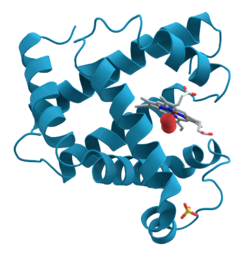Biology:HOXC6
 Generic protein structure example |
Homeobox protein Hox-C6 is a protein that in humans is encoded by the HOXC6 gene.[1][2][3] Hox-C6 expression is highest in the fallopian tube and ovary.[4] HoxC6 has been highly expressed in many types of cancers including prostate, breast, and esophageal squamous cell cancer.[5]
Function
This gene belongs to the homeobox family, members of which encode a highly conserved family of transcription factors that play an important role in morphogenesis in all multicellular organisms. Mammals possess four similar homeobox gene clusters, HOXA, HOXB, HOXC and HOXD, which are located on different chromosomes and consist of 9 to 11 genes arranged in tandem. This gene, HOXC6, is one of several HOXC genes located in a cluster on chromosome 12. Three genes, HOXC5, HOXC4 and HOXC6, share a 5' non-coding exon. Transcripts may include the shared exon spliced to the gene-specific exons, or they may include only the gene-specific exons. Alternatively spliced transcript variants encoding different isoforms have been identified for HOXC6. Transcript variant two includes the shared exon, and transcript variant one includes only gene-specific exons.[3] HOXC6 plays a role in lymphoma. The HOXC6 isoform, HOXC6-2 is an active carcinogenic for gastric cancer. It stimulates gastric cancer cells proliferation by acting as an oncogene. Downregulation of this gene’s isoforms could potentially lead to less proliferation of certain cancerous cells. With the HOXC6-1 isoform, there were no statistically significant effects on migration, invasion, apoptosis, or proliferation when it was downregulated.[6] According to a study in Cancer Cell International, suppression of the HOXC6 gene plays a role in blocking the TGF-β/SMAD cascade. This then leads to the weakening of epithelial to mesenchymal transition for the cervical carcinoma.[7]
Knock-out model
A knockout model using small interfering RNA showed that knockout of HOXC6 was associated with apoptosis. Additionally, the presence of HOXC6 was associated with inhibition of paclitaxel-induced apoptosis. Thus, HOXC6 was demonstrated to induce proliferative activity.[8]
See also
References
- ↑ "Nomenclature for human homeobox genes". Genomics 7 (3): 460. July 1990. doi:10.1016/0888-7543(90)90186-X. PMID 1973146.
- ↑ "Vertebrate homeobox gene nomenclature". Cell 71 (4): 551–553. November 1992. doi:10.1016/0092-8674(92)90588-4. PMID 1358459.
- ↑ 3.0 3.1 "Entrez Gene: HOXC6 homeobox C6". https://www.ncbi.nlm.nih.gov/sites/entrez?Db=gene&Cmd=ShowDetailView&TermToSearch=3223.
- ↑ "Tissue expression of HOXC6 - Summary - The Human Protein Atlas". https://www.proteinatlas.org/ENSG00000197757-HOXC6/tissue.
- ↑ "HOXC6 promotes migration, invasion and proliferation of esophageal squamous cell carcinoma cells via modulating expression of genes involved in malignant phenotypes". PeerJ 7: e6607. 2019-03-14. doi:10.7717/peerj.6607. PMID 30886783.
- ↑ "HoxC6 Functions as an Oncogene and Isoform HoxC6-2 May Play the Primary Role in Gastric Carcinogenesis". Digestive Diseases and Sciences 65 (10): 2896–2906. October 2020. doi:10.1007/s10620-019-06013-7. PMID 31900716.
- ↑ "HOXC6 gene silencing inhibits epithelial-mesenchymal transition and cell viability through the TGF-β/smad signaling pathway in cervical carcinoma cells". Cancer Cell International 18 (1): 204. December 2018. doi:10.1186/s12935-018-0680-2. PMID 30559605.
- ↑ "HOXC6 is deregulated in human head and neck squamous cell carcinoma and modulates Bcl-2 expression". The Journal of Biological Chemistry 287 (42): 35678–35688. October 2012. doi:10.1074/jbc.M112.361675. PMID 22896703.
Further reading
- "The human HOX gene family". Nucleic Acids Research 17 (24): 10385–10402. December 1989. doi:10.1093/nar/17.24.10385. PMID 2574852.
- "Organization of human class I homeobox genes". Genome 31 (2): 745–756. 1990. doi:10.1139/g89-133. PMID 2576652.
- "Cognate homeo-box loci mapped on homologous human and mouse chromosomes". Proceedings of the National Academy of Sciences of the United States of America 83 (23): 9104–9108. December 1986. doi:10.1073/pnas.83.23.9104. PMID 2878432. Bibcode: 1986PNAS...83.9104R.
- "Two human homeobox genes, c1 and c8: structure analysis and expression in embryonic development". Proceedings of the National Academy of Sciences of the United States of America 84 (14): 4914–4918. July 1987. doi:10.1073/pnas.84.14.4914. PMID 2885844. Bibcode: 1987PNAS...84.4914S.
- "At least three human homeoboxes on chromosome 12 belong to the same transcription unit". Nucleic Acids Research 16 (12): 5379–5390. June 1988. doi:10.1093/nar/16.12.5379. PMID 2898768.
- "Nucleolar localisation of three Hox homeoproteins". Journal of Cell Science 108 ( Pt 1) (1): 187–193. January 1995. doi:10.1242/jcs.108.1.187. PMID 7738096.
- "Fine mapping of human HOX gene clusters". Cytogenetics and Cell Genetics 73 (1–2): 114–115. 1996. doi:10.1159/000134320. PMID 8646877.
- "Cloning and expression of a new HOXC6 transcript encoding a repressing protein". The Biochemical Journal 319 ( Pt 1) (1): 91–97. October 1996. doi:10.1042/bj3190091. PMID 8870653.
- "Complete mutation analysis panel of the 39 human HOX genes". Teratology 65 (2): 50–62. February 2002. doi:10.1002/tera.10009. PMID 11857506.
- "Loss of HOXC6 expression induces apoptosis in prostate cancer cells". Oncogene 24 (1): 188–198. January 2005. doi:10.1038/sj.onc.1207906. PMID 15637592.
- "Differentiation of insulin-producing cells from human neural progenitor cells". PLOS Medicine 2 (4): e103. April 2005. doi:10.1371/journal.pmed.0020103. PMID 15839736.
- "Diversification of transcriptional modulation: large-scale identification and characterization of putative alternative promoters of human genes". Genome Research 16 (1): 55–65. January 2006. doi:10.1101/gr.4039406. PMID 16344560.
- "HOXC6 and HOXC11 increase transcription of S100beta gene in BrdU-induced in vitro differentiation of GOTO neuroblastoma cells into Schwannian cells". Journal of Cellular and Molecular Medicine 11 (2): 299–306. 2007. doi:10.1111/j.1582-4934.2007.00020.x. PMID 17488478.
External links
- HOXC6+protein,+human at the US National Library of Medicine Medical Subject Headings (MeSH)
This article incorporates text from the United States National Library of Medicine, which is in the public domain.
 |





